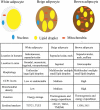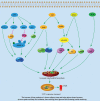Brown and beige adipose tissue: a novel therapeutic strategy for obesity and type 2 diabetes mellitus
- PMID: 33403891
- PMCID: PMC7801117
- DOI: 10.1080/21623945.2020.1870060
Brown and beige adipose tissue: a novel therapeutic strategy for obesity and type 2 diabetes mellitus
Abstract
Mammalian adipose tissue can be divided into two major types, namely, white adipose tissue (WAT) and brown adipose tissue (BAT). According to classical view, the main function of WAT is to store excess energy in the form of triglycerides, while BAT is a thermogenic tissue that acts a pivotal part in maintaining the core body temperature. White adipocytes display high plasticity and can transdifferentiate into beige adipocytes which have many similar morphological and functional properties with brown adipocytes under the stimulations of exercise, cold exposure and other factors. This phenomenon is also known as 'browning of WAT'. In addition to transdifferentiation, beige adipocytes can also come from de novo differentiation from tissue-resident progenitors. Activating BAT and inducing browning of WAT can accelerate the intake of glycolipids and reduce the insulin secretion requirement, which may be a new strategy to improve glycolipids metabolism and insulin resistance of obese and type 2 diabetes mellitus (T2DM) patients. This review mainly discusses the significance of brown and beige adipose tissues in the treatment of obesity and T2DM, and focuses on the effect of the browning agent on obesity and T2DM, which provides a brand-new theoretical reference for the prevention and treatment of obesity and T2DM.
Keywords: Brown adipose tissue; beige adipose tissue; browning of white adipose tissue; obesity; type 2 diabetes mellitus; white adipose tissue.
Conflict of interest statement
The authors declare that they have no competing interest.
Figures





References
-
- Kohlgruber A, Lynch L.. Adipose tissue inflammation in the pathogenesis of type 2 diabetes. Curr Diab Rep. 2015;15(11):92. - PubMed
-
- Duclos M. Osteoarthritis, obesity and type 2 diabetes: the weight of waist circumference. Ann Phys Rehabil Med. 2016;59(3):157–160. - PubMed
-
- International Diabetes Federation . IDF diabetes Atlas. 9th ed. Brussels, Belgium: International Diabetes Federation; 2019.
-
- Aherne W, Hull D. Brown adipose tissue and heat production in the newborn infant. J Pathol Bacteriol. 1966;91(1):223–234. - PubMed
Publication types
MeSH terms
LinkOut - more resources
Full Text Sources
Other Literature Sources
Medical
